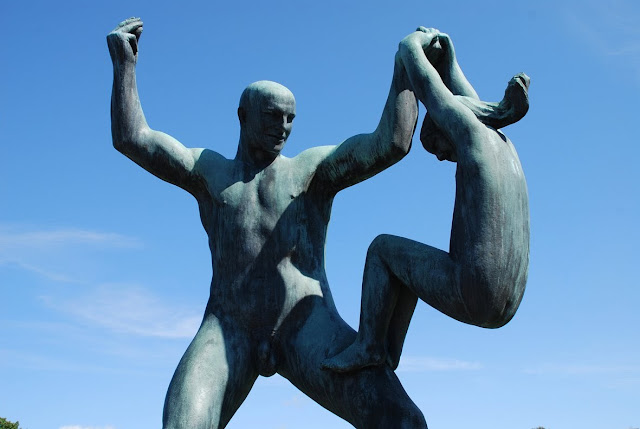 |
| The view across the fjord |
For a capital city, Oslo is surprisingly small and compact – it's the perfect size for exploring on foot. Better yet, there is something to suit everyone. For art conoisseurs, there's Nasjonalgalleriet (the National Gallery), home to Edvard Munch's iconic painting The Scream. Would-be Vikings will feel at home in Vikingskipshuset, where you can see the remains of three 9th century Viking longboats. Explorer types will love Frammuseet (the Fram Museum), which houses the polar ship Fram, once captained by Roald Amundsen. Meanwhile, modern architecture fans will want to climb all over Oslo's latest architectural offering – Operahuset (the Opera House).
 |
| The roof of the opera house angles to ground level, inviting pedestrians to walk up and enjoy the panoramic views of Oslo |
Another visit-worthy sight is Oslo Domkirke (cathedral). Built in 1697, Oslo Cathedral is worth seeing for its elaborate stained glass by Emanuel Vigeland (brother of Gustav) and painted ceiling, which was completed between 1936 and 1950.
 |
| Inside Oslo Cathedral |
 |
| Candles in the Cathedral |
One of my favourite sights was Akershus Slott og Festning (Akershus Castle and Fortress). Ordinarily on sunny days I spend all my time outside, but something tempted me to venture into the castle. I was very glad it did, although it would take a better photographer than me to do it justice!
In 1299, King Håkon V ordered the building of this medieval castle and fortress in response to an earlier attack on Oslo by a Norwegian nobleman. Its strategic location at the very end of the headland and proximity to the sea enabled it to withstand numerous sieges throughout the Middle Ages.
It was renovated in the 17th century by Christian IV who turned it into a Renaissance palace, albeit one with a steadfastly medieval front! The upper floors comprised lavish banquet halls and staterooms while several floors below, in stark contrast, the cold, dark dungeons were used to hold outcast nobles. Later still, in the first half of the 19th century, the fortress was used as a prison. Today it is the headquarters of the Norwegian Ministry of Defence and is used to hold major events and government functions.
 |
| The school chamber where the Danish governor's children would have their lessons |
 |
| The view from Akershus Castle |
 |
| The church |
 |
| The hall of Christian IV |
 |
| Romerike Hall |
 |
| The hall of Olav V |
No trip to Oslo would be complete without a visit to Vigeland Sculpture Park, an extraordinary open-air showcase of work by Norway's best-loved sculptor, Gustav Vigeland. The park is home to over 200 granite and bronze Vigeland works, ranging from entwined lovers and tranquil elderly couples to contempt-ridden beggars. The crowning glory is, of course, the monolith, which comprises 121 carved figures and stands 17.3m high.
 |
| No. 24: dancing young woman (circa 1930) |
 |
| No. 9: man lifting girl with one arm (circa 1928) |
 |
| No. 8: two girls standing on their heads, smiling (1921) |
 |
| The monolith |
Oslo was one of those cities that surprised me, perhaps because, unlike the feted European capitals such as Paris or Rome, I had no preconceived ideas about it. I took it for what it was – a small but perfectly formed capital that still manages to maintain a small-town feel. I only spent two days there but I loved it. Not for the first did I realise how lucky I am – a realisation that just days later was to become all the more poignant – to be able to travel so frequently and to visit such beautiful places.
Two days after I left the city and flew to Helsinki, a right-wing extremist detonated a car bomb in central Oslo, killing eight people and injuring a further 209. He then made his way to Utøya island where the AUF, the youth division of the ruling Norwegian Labour Party, was holding its annual summer camp and opened fire on the participants, killing 69 of them and injuring at least 110 more. It was the deadliest attack on Norway since WWII and it left this usually peaceful country and the rest of the Western World in shock.
I found out via Facebook. It was hard to equate those acts with the beautiful, laid-back city I'd just left, and even harder to believe that anyone was capable of such cold-blooded actions. I had such a lovely time in Oslo, but my memories of that trip will be forever tinged with sadness when I think of the huge number of lives lost and destroyed just days later.
No comments:
Post a Comment